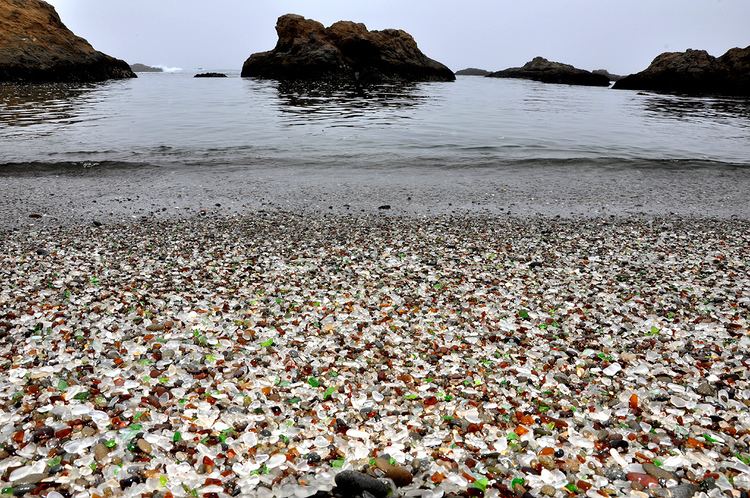Established 1949 | Area 15 ha | |
 | ||
Governing body California Department of Parks and Recreation Similar MacKerricher State Park, Mendocino Coast Botanical, Redwood National and State, Pfeiffer Big Sur State Park, Papakolea Beach | ||
Glass Beach is a beach in MacKerricher State Park near Fort Bragg, California, that is abundant in sea glass created from years of dumping garbage into an area of coastline near the northern part of the town.
Contents
Map of Glass Beach, Fort Bragg, CA 95437, USA
History
In 1906, Fort Bragg residents established an official water dump site behind the Union Lumber Company onto what is now known as "Site 1". Most water fronted communities had water dump sites discarding glass, appliances, and even vehicles. Locals referred to it as "The Dumps." Fires were often lit to reduce the size of the trash pile.
When the original dump site filled in 1943, the site was moved to what is now known as "Site 2", the active dump site from 1943 until 1949.
When this beach filled in 1949, the dump was moved north to what is now known as "Glass Beach", which remained an active dump site until 1967.
The California State Water Resources Control Board and city leaders closed this area in 1967. Various cleanup programs were undertaken through the years to correct the damage. Over the next several decades, what was biodegradable in the dump sites simply degraded and all the metal and other items were eventually removed and sold as scrap or used in art. The pounding waves broke down the glass and pottery and tumbled those pieces into the small, smooth, colored pieces that often become jewelry quality and that cover Glass Beach and the other two glass beaches (former dump sites) in Fort Bragg.
There are three Glass Beach sites in Fort Bragg where trash was dumped into the ocean between 1906 and 1967. Site Two (1943-1949) and Three (1949–1967 - "Glass Beach") are located at the end of the path that begins on the corner of Elm Street and Glass Beach Drive. These sites are accessible by foot and by a short climb down the cliffs surrounding the beach. Site One (1906–43) is 1/4 mile south of Site Two and has become accessible by foot as of January 2015 when the northern section of the new Coastal Trail in Fort Bragg opened.
In 1998, the private owner of the property began a five-year process of working with the California Coastal Conservancy and the California Integrated Waste Management Board for the cleanup and sale of the property to the state. Following completion of the clean up, the California Department of Parks and Recreation purchased the 38-acre (15 ha) Glass Beach property, and it was incorporated into MacKerricher State Park in October 2002.
Most of the actual "Glass Beach", Site 3, is "adjacent" to MacKerricher State Park. All entities in California end at the mean high water mark (MHW), according to Article 10 of the state constitution. In Fort Bragg, the mean high water mark is 5.2', and most of Glass Beach is below that water mark.
Sites 1 & 2 are located south of "Glass Beach" and do not abut the state park area, though they abut the new city park area, which also ends at the mean high water mark (MHW).
Tourism
The beach is now visited by tens of thousands of tourists yearly. Collecting is discouraged on the section of "Glass Beach" within and adjacent to the state park, although most of the sea glass is now found on the other two glass beaches outside the state park area.
About 1,000 to 1,200 tourists visit Fort Bragg's glass beaches each day in the summer. Most collect some glass. Because of this and also because of natural factors (wave action is constantly grinding down the glass), the glass is slowly diminishing. There is currently a movement by Captain J.H. (Cass) Forrington to replenish the beaches with discarded glass. On December 10, 2012, the City Council of the City of Fort Bragg discussed the beach glass depletion and declined to move forward with replenishment efforts due to the cost and perceived likelihood that required permits would not be approved.
Similar beaches are found in Benicia, California and Hanapepe, Hawaii.
Plants and animals
Several endangered and protected native plants occur at Glass Beach including hybrid Menzies’ wallflower.
